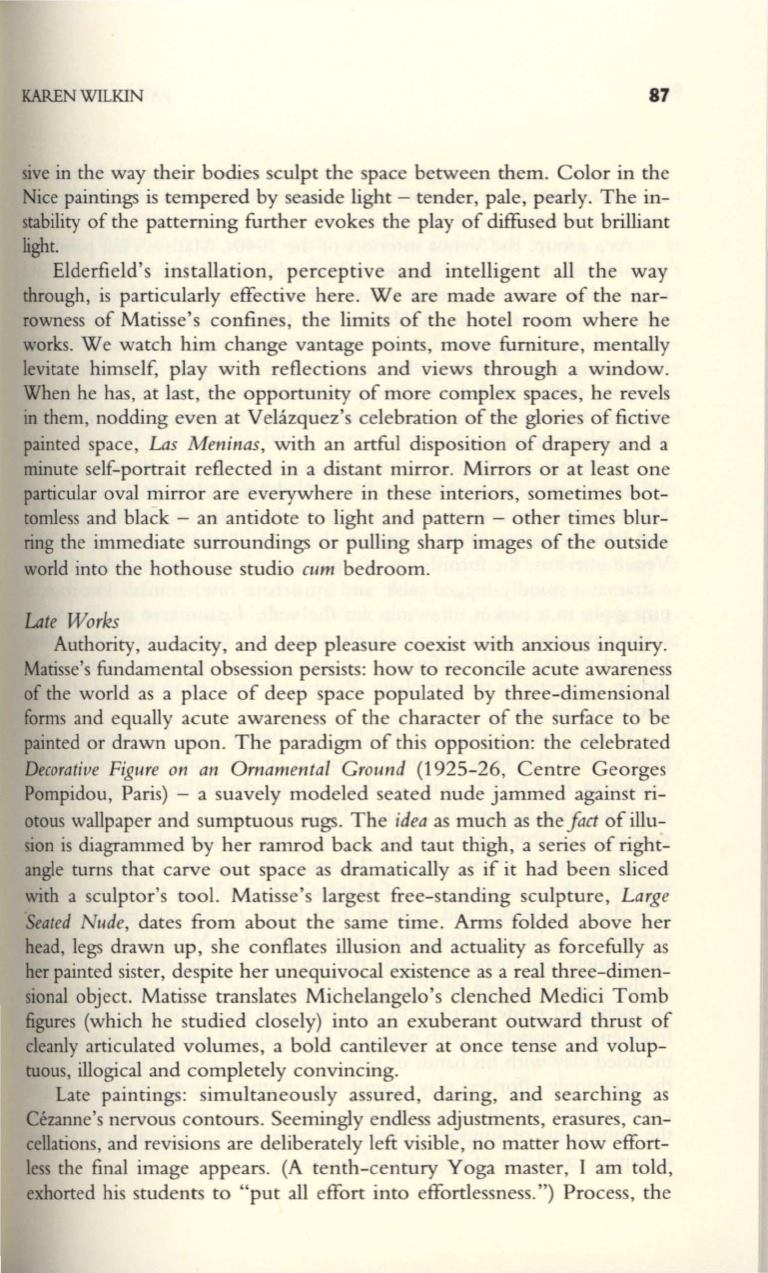
KAREN WILKIN
87
sive in the way their bodies sculpt the space between them. Color in the
Nice paintings is tempered by seaside light - tender, pale, pearly. The in–
stability of the patterning further evokes the play of diffused but brilliant
light.
Elderfield's installation, perceptive and intelligent all the way
through, is particularly effective here. We are made aware of the nar–
rowness of Matisse's confines, the limits of the hotel room where he
works. We watch him change vantage points, move furniture, mentally
levitate himself, play with reflections and views through a window.
When he has, at last, the opportunity of more complex spaces, he revels
in
them, nodding even at Velazquez's celebration of the glories of fictive
painted space,
Las Meninas,
with an artful disposition of drapery and a
minute self-portrait reflected in a distant mirror. Mirrors or at least one
particular oval mirror are everywhere in these interiors, sometimes bot–
tomless and black - an antidote to light and pattern - other times blur–
ring the immediate surroundings or pulling sharp images of the outside
world into the hothouse studio
cum
bedroom.
LAte Works
Authority, audacity, and deep pleasure coexist with anxious inquiry.
Matisse's fundamental obsession persists: how to reconcile acute awareness
of the world as a place of deep space populated by three-dimensional
fonns and equally acute awareness of the character of the surface to be
painted or drawn upon. The paradigm of this opposition: the celebrated
Decorative Figure on an Ornamental Ground
(1925-26, Centre Georges
Pompidou, Paris) - a suavely modeled seated nude jammed against ri–
otous wallpaper and sumptuous rugs. The
idea
as much as the
fact
of illu–
sion is diagrammed by her ramrod back and taut thigh, a series of right–
angle turns that carve out space as dramatically as if it had been sliced
with a sculptor'S tool. Matisse's largest free-standing sculpture,
Large
Seated Nude,
dates from about the same time. Arms folded above her
head, legs drawn up, she con£lates illusion and actuality as forcefully as
her painted sister, despite her unequivocal existence as a real three-dimen–
sional object. Matisse translates Michelangelo's clenched Medici Tomb
figures (which he studied closely) into an exuberant outward thrust of
cleanly articulated volumes, a bold cantilever at once tense and volup–
tuous, illogical and completely convincing.
Late paintings: simultaneously assured, daring, and searching as
Cezanne's nervous contours. Seemingly endless adjustments, erasures, can–
cellations, and revisions are deliberately left visible, no matter how effort–
less the final image appears. (A tenth-century Yoga master, I am told,
exhorted his students to "put all effort into effortlessness.") Process, the


